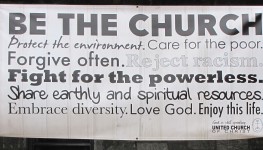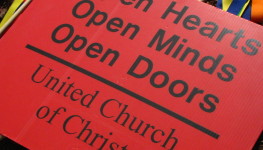“Resurrection Conspiracy”
Luke 24:36-48
I hesitate to tell you this but, just by being here today, we are engaging in an act of resistance.
Just by showing up to worship on the third Sunday of Easter, by considering even the possibility of resurrection, we are committing a subversive act. And the fact that we are here as a community of Jesus followers and resurrection considerers—even if we’re not all physically in the same space? Well, we are part of a conspiracy!
We are resisting the dominant culture of death. We are conspiring to subvert the prevailing narratives that greed is good, might makes right, and death is forever.
No matter how unorthodox our theology, regardless of how many doubts we have, our faith in the God of Life and New Life is consequential. It is dangerous. It is revolutionary.
And those are only some of the reasons such a faith is hard to hang on to. The potential consequences of such resistance are just a few of the justifications we have for hiding our faith-light under a bushel. The subversiveness of following Jesus with our whole heart is just one reason we’re often embarrassed to mention his name.
Of course, there are plenty of reasons to doubt not only the physical resurrection of Jesus but also his very identity. Doubts are real and valid; doubts deserve a seat of honor at the table of faith.
But let’s be honest here: Let’s not use our doubts as an excuse to avoid a life of discipleship. Countless numbers of people from all faiths and no faith have committed themselves to living according to the nonviolent, loving, life-giving ways of Jesus. The life of faith has less to do with beliefs than practices, and following the practices of Jesus can have concrete consequences.
I would go so far as to say that it should have consequences. Living a life of faith should set us apart. It should leave no one wondering where we stand on basic questions of justice and peace, solidarity and community, and the essential issue of life itself.
I say this all this not only because it is the Third Sunday of Easter. Not only because our gospel lesson has the Risen Christ going out of his way to prove to his frightened and disbelieving disciples that he is the real deal. Not only because we would also love to be able to touch him and see his wounded hands and feet. Not only because we, too, are witnesses to Love’s triumph over evil and death.
I feel it is important to name the subversiveness of our faith today because the world so clearly needs a faith like ours, a conspiracy of life like ours. Because it is becoming clearer and clearer that the powers of death, division, and denial are tearing us apart. Because we cannot—we must not—ignore the suffering, pain, and despair of our neighbors, especially our neighbors of color.
We may wonder what the police killings of George Floyd, Daunte Wright, and Adam Toledo have to do with our faith. We may wonder what the latest mass shooting, our nation’s worship of guns and individual freedoms, or the police assault on U.S. Lieutenant Caron Nazario has to do with Jesus.
I would suggest that the resurrection has everything to do with how we respond to a pandemic that has killed some 3 million people around the world—some 566,000 of them Americans—and still some people cannot be bothered to wear face masks. I would suggest that our witness to the Risen Christ must be relevant when, according to the New York Times, “more than three people a day have died at the hands-off police” since the beginning of the trial of George Floyd’s killer. And when the defense of Derek Chauvin would have us believe that George Floyd “somehow killed himself” and a common response to police violence is that the victims should have cooperated, I think we would do well to consider that we follow a brown-skinned Messiah who was executed by the state.
We are witnesses of these things.
Although we are surrounded by death and a mind-boggling indifference to it, we profess a faith in new and resurrected life. We follow a savior who, even on the other side of the tomb, bears the scars of injustice and fear. We worship a God who is, even now, doing a new thing.
And, still, I have a new appreciation for the Easter Sunday disciples, cowering in fear and grief behind locked doors. I can understand their instinct to protect themselves from all the evil and violence of empire. I can relate to their effort to barricade themselves against the submissive fear and resignation of so many in their community. And I’m beginning to understand—beyond the basic physics of the situation—why they wouldn’t immediately believe that this was their executed teacher now standing before them and asking for something to eat.
They had put so much hope in Jesus—for what? They had made his vision of the realm of God their own—but to what end?
Beloveds, I want to encourage us to consider the hopelessness and anger so many of our siblings of color are feeling. I want to suggest that those of us who are white, those of us who have never been pulled over by police or, when we have, were never ordered to get out of the car, that perhaps we should not be telling our siblings of color what to do, how to feel, how to protest, or how to grieve in these times of killing after killing after killing.
When the Risen Christ appeared to the devastated disciples, he offered them peace and compassion. He came not in triumph but in vulnerability, showing them his wounds and sharing his need./p>
“Touch me and see that it is I, myself,” he said.
He made it clear that he was still with them, that though he had told them before, he would always be with them. He explained to them that this good news was meant not only for them, and that it was not meant to stay behind closed doors.
“You are witnesses to these things,” he said. Share this good news with all the world.
The point is not to try to be subversive, of course. The challenge is not to live from a place of intentional resistance, ever-simmering anger or hatred.
The Easter invitation is to give ourselves over to new, resurrection life, and to plant ourselves firmly, with Jesus, on the side of love and life for all. The challenge is to understand that this resurrection faith will put us on the opposite side of the powers that be, that it will leave us standing against the prevailing winds of self-concern and indifference, that it will put us in league with the least, the lost, and the left behind. That we too will bear the wounds of the world.
What a gift it is to be in this resurrection conspiracy together!




